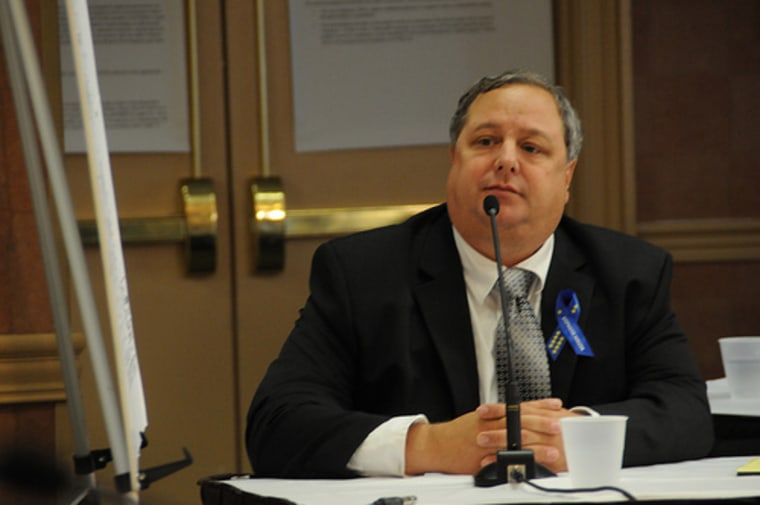Before rig workers aboard the doomed Deepwater Horizion drilling platform performed a procedure that BP says may have been a "fundamental mistake," there was a "skirmish" between BP and Transocean staff about whether to proceed, the rig's chief mechanic told federal investigators on Wednesday.
The testimony corroborated other witness statements obtained by The Associated Press that show Transocean managers complained BP was "taking shortcuts" the day of the explosion by replacing heavy drilling fluid with saltwater in the well that blew out.
The accounts could give Transocean more ammunition in its verbal battle with BP to assign blame for the disaster, which caused what is likely the biggest oil spill in U.S. history.
Speaking to a federal board of investigators in Kenner, Louisiana, mechanic Douglas Brown said that around noon on April 20, the day of the explosion, rig workers met in a room adjacent to the rig's galley and "there was a slight argument that took place and a difference of opinions."
Brown said "a skirmish" took place between "the company man" from BP — whose name he said he did not know — and three Transocean employees.
"The company man was basically saying, 'Well this is how it's going to be,'" and Transocean rig workers "reluctantly agreed," Brown said.
Brown said the top Transocean official on the rig grumbled, "Well, I guess that's what we have those pinchers for" — which he took to be a reference to devices on the blowout preventer, the five-story piece of equipment that can slam a well shut in an emergency.
The argument concerned "displacing the riser," Brown said, a reference to a decision made by rig personnel to remove heavy drilling mud from the drill pipe and replace it with sea water, in an attempt to wrap up drilling operations and plug the well with cement until it was ready for production.
Drilling mud is a mixture of synthetic ingredients that is pumped into the well to exert downward pressure and prevent a column of oil and gas from rushing up the pipe.
The switch presumably would have allowed the company to remove the fluid and use it for another project, but the seawater would have provided less weight to counteract the surging pressure from the ocean depths.
Because water is lighter and less dense than mud, the procedure allowed a flood of flammable methane gas to surge up the drill pipe, which ignited and led to a catastrophic fire, according to documents from the House Energy and Commerce Committee.
Conflicting pressure tests
Congressional investigators say BP and Transocean made a decision late on April 20 to begin removing mud from within the drill pipe despite pressure tests from within the well that a BP official described as "not satisfactory" and "inconclusive."
Earlier in the day, well pressure tests showed an imbalance between the drill pipe choke and kill lines running from the drill deck to the blowout preventer. The pressure in the drill pipe was 1,400 pounds per square inch, while the choke and kill lines read zero PSI, according to BP documents gathered by the House Energy and Commerce Committee.
In BP's internal investigation, made public by the committee, BP said it might have been a "fundamental mistake" to continue with the procedure because there was an "indication of a very large abnormality."
The statements obtained by The Associated Press include those by Truitt Crawford, a Transocean worker who told Coast Guard investigators about similar complaints.
"I overheard upper management talking saying that BP was taking shortcuts by displacing the well with saltwater instead of mud without sealing the well with cement plugs, this is why it blew out," Crawford said in his statement.
BP declined to comment.
The statements also show that workers talked just minutes before the blowout about pressure problems in the well. At first, nobody seemed too worried: The chief mate for Transocean left two crew members to deal with the issue on their own.
What began as a routine pressure problem, however, suddenly turned to panic. The workers called bosses to report a situation, with assistant driller Stephen Curtis telling one senior operator that the well was "coming in." Someone told well site leader Donald Vidrine that they were "getting mud back." The drilling supervisor, Jason Anderson, tried to shut down the well.
It didn't work. Both Curtis and Anderson died in the explosion.
'Complete mayhem, chaos'
Brown said that as methane surged up the drill pipe and enveloped the rig, a loud hiss of gas escaped from the well, which set off a stream of alarms.
"Gas alarms just kept piling up on top of each other more and more and more," Brown said. The rig was hit by a power blackout, and the explosion came soon after, he said.
"The first explosion basically threw me up against the control panel that I was standing in front of," Brown said.
As Brown raced to reach the rig's lifeboats, "it was just complete mayhem, chaos, people were scared, they were crying," Brown said.
The rig worker taking a muster of workers boarding the lifeboat, a man that Brown said he had known for nine years, did not recognize him. "This is a man that has known me for nine years and he cannot even remember my name," Brown said.
"It was just completely chaotic and nobody was really paying attention in my opinion," Brown said. "They were more concerned about just getting off the rig — escaping."
